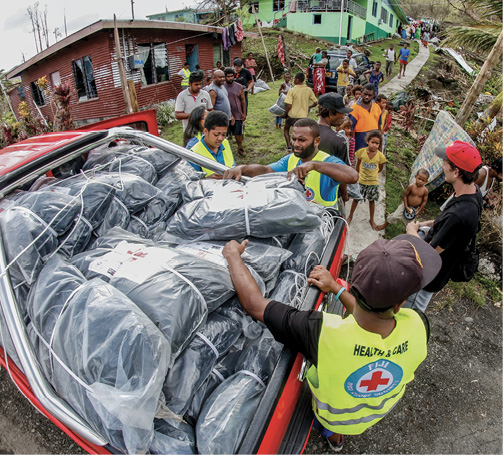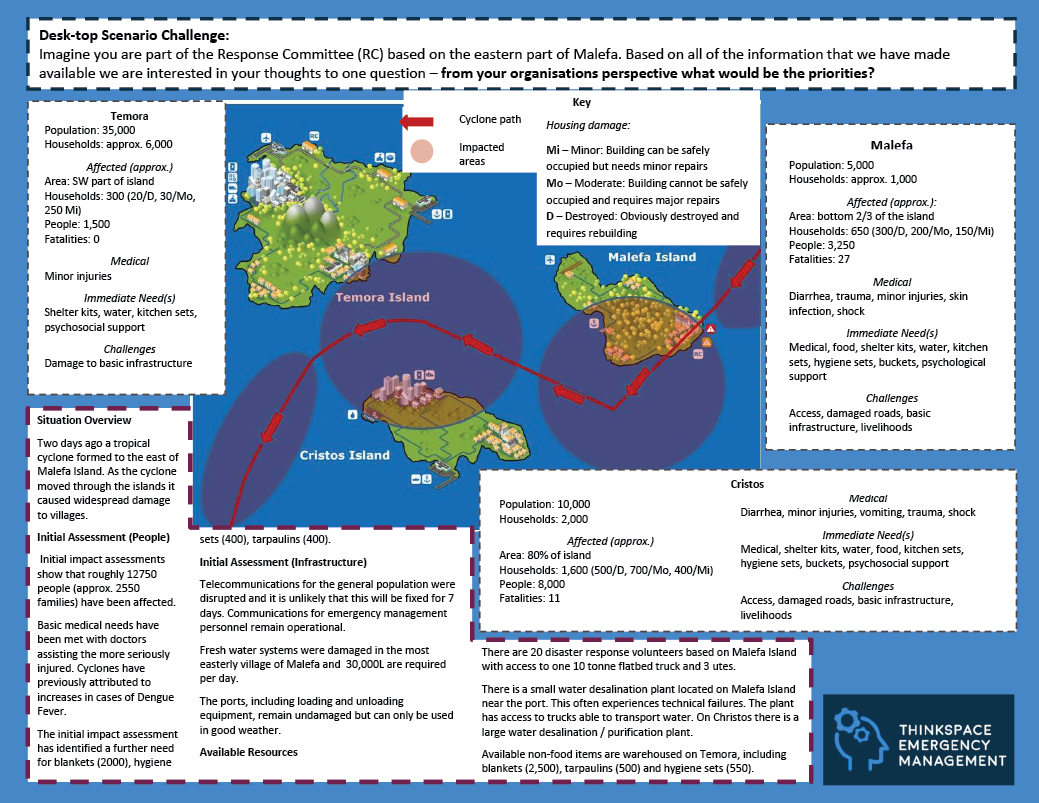
By Caragh Robinson, Catherine Harris, Steve Ray and Ian Morrison, Red Cross
In January 2016, Australian Red Cross conducted a simulation exercise to test organisational readiness for large-scale emergency responses. A month later, Fiji was hit by the strongest cyclone ever recorded in the southern hemisphere. The simulation exercise helped Australian Red Cross improve the speed and efficiency with which it was able to support its local partner, Fiji Red Cross Society, in responding to Cyclone Winston. In particular the exercise helped Australian Red Cross clarify contact points for operational and logistical matters, improve understanding of safety and security processes, and strengthen public messaging in emergencies.

On 20 February 2016, severe tropical Cyclone Winston made landfall in Fiji. The cyclone cut an erratic path, doubling back on itself after passing through Tonga before developing into a category five system as it tracked through the centre of Fiji.
While the most populous cities of Suva and Nadi avoided a direct impact, all Fiji’s islands experienced highly-destructive winds, heavy rains, strong storm surges, flash flooding and landslides. At its peak, the cyclone caused wind gusts of 325 km per hour, making Cyclone Winston the strongest storm on record in the southern hemisphere.
The cyclone affected an estimated 350,000 people. The official death toll was 44, while a further 156 people were reported injured. Communications and power services were disrupted in many parts of the country; over 32,000 houses were damaged or destroyed, and 250,000 people were left in need of emergency water, sanitation and hygiene assistance.1
The International Red Cross Red Crescent Movement mobilised resources in the days prior to the storm making landfall. As the cyclone approached, Australian Red Cross was closely involved in planning and preparation with Fiji Red Cross and the IFRC.
Fiji Red Cross was one of the first local agencies to respond to the cyclone, sending out assessment teams as soon as it was safe to do so, and distributing tarpaulins and other relief supplies from its storehouses across the country. Australian Red Cross launched a public appeal and worked with the Australian Government Department of Foreign Affairs and Trade to identify ways to fund and support the relief operation.
Australian Red Cross had been preparing for this emergency long before Cyclone Winston formed. With a history of supporting the Red Cross Red Crescent Movement in disasters and crises all over the world, the organisation continually reviews and improves its response capacity.
In January 2016, Australian Red Cross conducted a day-long disaster response simulation exercise, facilitated by Thinkspace Emergency Management and involving Australian-based and offshore staff from its International Programs division. The exercise tested organisational readiness for a large-scale international emergency response.
The Pacific area is highly prone to disasters such as cyclone, floods and drought; and the geographic isolation of many Pacific islands can make disaster response challenging. Hence, the Australian Red Cross simulation involved a category five cyclone approaching the fictional Pacific Island nation of Palinga. The exercise tested:
Lessons from the simulation directly contributed to the speed and efficiency the Australian Red Cross was able to respond to Cyclone Winston. These include:
The simulation revealed a need to clarify the process for communicating with other Red Cross Red Crescent Movement partners. Australian Red Cross quickly identified appropriate internal and external contact points for safety and security issues, operations, logistics and surge human resources. Thus, as soon as Cyclone Winston was identified as a threat, the International Programs team could involve all relevant people in key decisions about the response.
Immediately following the cyclone, Australian Red Cross was able to work with Fiji Red Cross and other partners to determine needs and priorities on the ground. This informed the launch of a public fundraising appeal and discussions with the Australian Government Department of Foreign Affairs and Trade. Funds could therefore be quickly allocated to dispatch necessary relief items and the deployment of aid workers with specific technical skills.

Australian Red Cross and the Australian Government worked together to replenish relief supplies that were being distributed by Fiji Red Cross teams in the Cyclone Winston response. Image: IFRC, Navneet Narayan.
The simulation was not only a valuable introduction or refresher for staff members, but also a means to evaluate the internal processes that underpin emergency response. As a result of the simulation, the team had a greater awareness of the safety and security processes involved in ensuring the wellbeing of Red Cross personnel in Fiji. Staff also demonstrated a greater understanding of their roles and responsibilities, including how to prepare for key meetings, produce reports and document decisions, as well as important finance and business processes.

The simulation highlighted areas where information could be quickly shared to strengthen public messaging during a crisis. This led to media training for Australian Red Cross staff based offshore. This helped secure a significant amount of media coverage of the Red Cross appeal and response to Cyclone Winston, including a partnership with the Australian Broadcasting Corporation that raised over $1 million for the appeal. When staff in Fiji expressed concerns about unsolicited goods being sent to the country, the communications team quickly created media articles 2, social media posts 3 and public enquiry messaging to encourage people to donate money or redirect second-hand goods to charity shops in Australia.
The simulation highlighted the important link between investing in disaster preparedness and improving response capacity. With positive outcomes apparent in a real-life disaster response, Australian Red Cross will continue to hold regular disaster simulations to further strengthen its ability to respond to crises. Future exercises will seek greater involvement from external key stakeholders.
1 UNOCHA 2016, Humanitarian Bulletin Cyclone Winston – Fiji, 22 April 2016. http://reliefweb.int/sites/reliefweb.int/files/resources/220416_humanitarian_bulletin.pdf.
2 Walton, P 2016, Fiji in need of monetary donations following Cyclone Winston, Courier-Mail, 23 February 2016. At: www.couriermail.com.au/news/opinion/fiji-in-need-of-monetary-donations-following-cyclone-winston/news-story/e32cbefce02bceaf6bec48db29e4b0bd.
3 Facebook post, Australian Red Cross, 23 February 2016. At: www.facebook.com/245602512221/posts/10154627112047222.